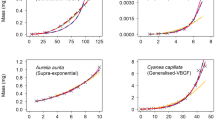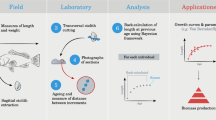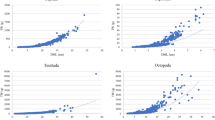Abstract
THE relative filamental surface area of the common British crayfish shows a tendency to decrease with increase in body size1. This seems to contradict the principle of similitude which states that the surface area of an animal is proportional to the square of its linear dimensions, whereas the volume (and the weight, for approximation) is proportional to the cube. Growth rates are known to differ in different organs of the same animal, and Huxley2 found quite empirically that organ to body relationship is better expressed by the equation:  where G is the size of organ examined (in dimension or weight units), W is the size of whole body (in dimension or weight units) and b and α are constants.
where G is the size of organ examined (in dimension or weight units), W is the size of whole body (in dimension or weight units) and b and α are constants.
This is a preview of subscription content, access via your institution
Access options
Subscribe to this journal
Receive 51 print issues and online access
$199.00 per year
only $3.90 per issue
Buy this article
- Purchase on Springer Link
- Instant access to full article PDF
Prices may be subject to local taxes which are calculated during checkout
Similar content being viewed by others
References
Curra, R. A., Ph.D. thesis, Univ. Edinburgh (1963).
Huxley, J. S., Nature, 114, 895 (1924).
Author information
Authors and Affiliations
Rights and permissions
About this article
Cite this article
CURRA, R. A Case of Negative Allometry in Austropotamobius Gill Growth. Nature 201, 842–843 (1964). https://doi.org/10.1038/201842b0
Issue Date:
DOI: https://doi.org/10.1038/201842b0
Comments
By submitting a comment you agree to abide by our Terms and Community Guidelines. If you find something abusive or that does not comply with our terms or guidelines please flag it as inappropriate.



